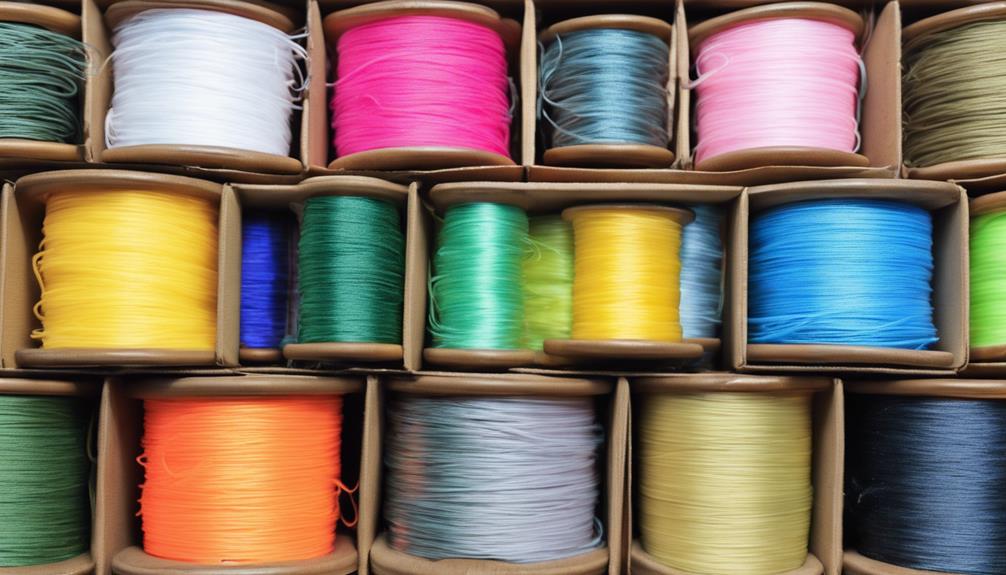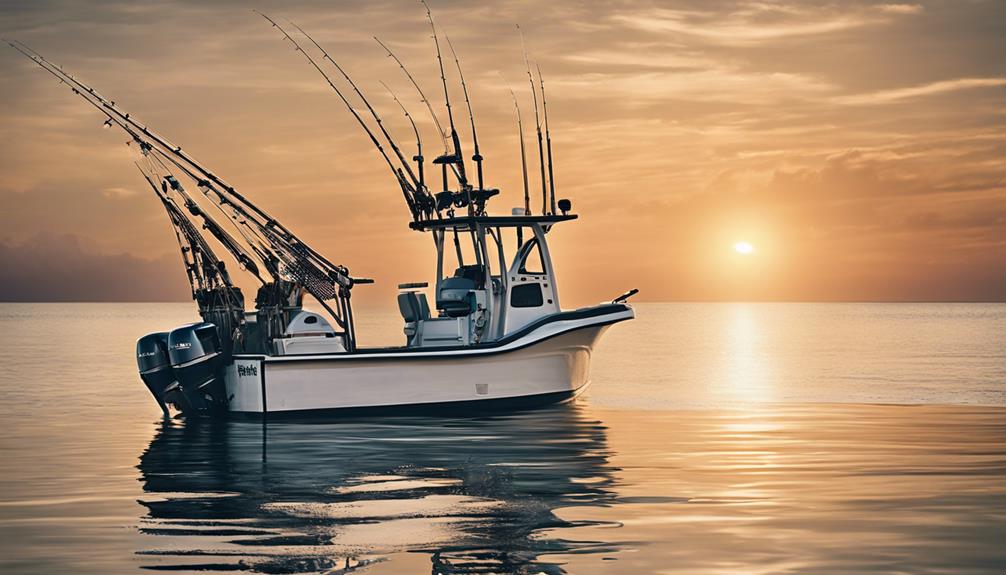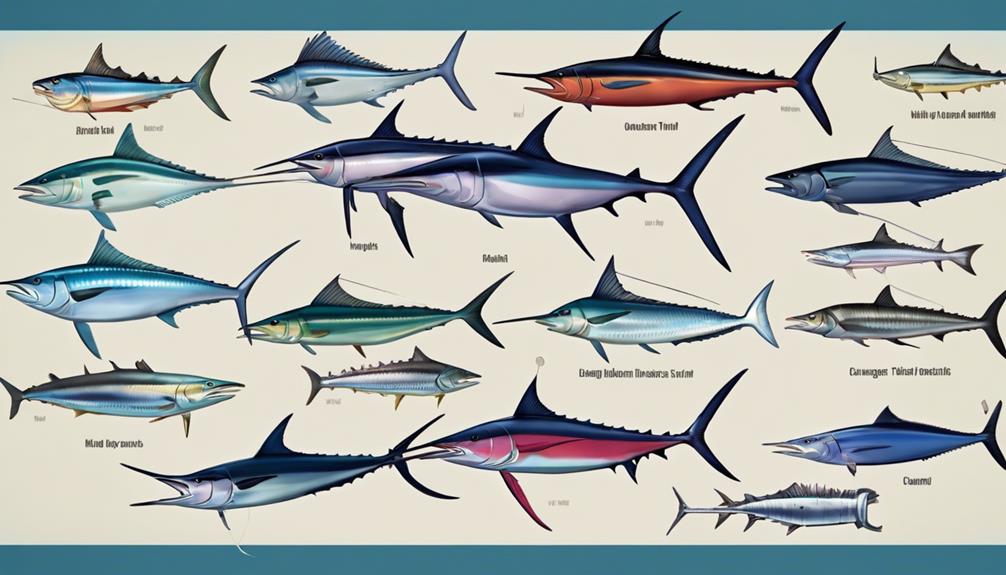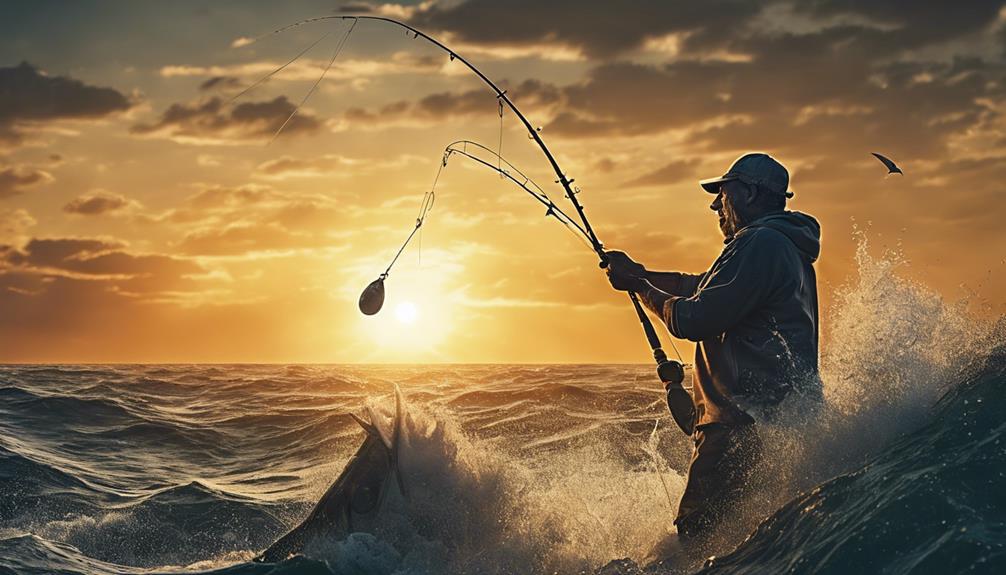Are you ready to elevate your deep sea fishing game with the best gear selections?
When navigating the vast ocean depths in pursuit of the ultimate catch, choosing the right equipment can make all the difference.
From specialized rods and reels to essential tackle box items, each piece plays a crucial role in ensuring a successful and memorable fishing expedition.
But what are the other six gear choices that can enhance your deep sea fishing adventures?
Rods and Reels
When embarking on deep-sea fishing adventures, selecting the right rods and reels is crucial for a successful and enjoyable experience. Your gear plays a significant role in determining the outcome of your fishing trip. To ensure your equipment is in top condition, regular rod maintenance is essential. Check for any signs of wear and tear, clean your rods after each use, and store them properly to prolong their lifespan. Additionally, consider reel upgrades to improve performance and durability, especially when targeting larger fish species in deep waters.
Mastering casting techniques is another vital aspect of deep-sea fishing. Practice different casting styles to cover more ground and increase your chances of a successful catch. Understanding how to adjust the tension on your reel and accurately control your cast will help you reach distant spots where fish are abundant. Moreover, perfecting your hook setting skills is crucial. A smooth and timely hook set can make the difference between a missed opportunity and a thrilling catch. Learn to feel the bite, avoid jerking the rod too quickly, and maintain steady pressure to secure your catch.
Tackle Box Essentials
To enhance your deep-sea fishing experience, ensuring your tackle box is stocked with essential gear is paramount. Tackle organization plays a crucial role in maximizing your efficiency on the water.
Invest in a tackle box with adjustable compartments, allowing you to customize the layout based on the size and type of tackle you have. This will help you keep your fishing gear neatly organized and readily accessible when you need to switch out lures or hooks quickly.
When it comes to hook selection, having a variety of sizes and styles is key to adapting to different fishing conditions. Make sure to include circle hooks, J-hooks, and treble hooks in your tackle box to cover a wide range of bait options and target species. Circle hooks are great for catch-and-release fishing as they often result in lip hooking, minimizing harm to the fish. J-hooks are versatile and work well with live bait, while treble hooks are ideal for artificial lures.
Safety Gear
Ensuring adequate safety gear is essential for your deep-sea fishing adventures to protect yourself and your fellow anglers in case of emergencies. When out on the open sea, it's crucial to have emergency flotation devices readily available. Make sure to have enough life jackets for everyone on board, as well as throwable flotation devices like lifebuoys. In the event of an accident or someone falling overboard, these items can be lifesaving.
Additionally, first aid supplies are a must-have on any fishing excursion. Stock your first aid kit with essentials like bandages, antiseptic wipes, pain relievers, and seasickness medication. Be prepared for common injuries and ailments that may occur while at sea.
Weather protection is also vital when deep-sea fishing. Pack rain gear, such as waterproof jackets and pants, to stay dry in case of unexpected rain or rough seas. Being exposed to the elements for an extended period can be dangerous, so it's essential to stay warm and dry.
Lastly, communication devices are crucial for staying connected and calling for help if needed. Invest in a reliable marine radio or satellite phone to reach out in emergencies or to check weather updates. These devices can be a lifeline in critical situations, ensuring you can quickly get assistance when required.
Navigation Tools
Having the right navigation tools is essential for ensuring a smooth and successful deep-sea fishing adventure. When you're out on the open water, knowing your precise location and finding the best spots to reel in those big catches can make all the difference. Here are some key navigation tools that can enhance your fishing experience:
- GPS Devices: These handy gadgets not only help you pinpoint your location but also allow you to mark hotspots for future trips, ensuring you never miss out on a great fishing spot.
- Fish Finders: Using sonar technology, fish finders help you locate schools of fish beneath the surface, increasing your chances of a successful haul and making your fishing expedition more fruitful.
- Sonar Technology: With advanced sonar capabilities, you can see underwater structures, identify fish species, and understand the underwater terrain better, giving you a significant advantage in finding the best fishing grounds.
- Compasses: While GPS devices are excellent, having a reliable compass as a backup is crucial for navigating in case of any technological failures. A compass is a simple yet effective tool for keeping you on the right course.
- Navigation Apps: Utilizing navigation apps on your smartphone or tablet can provide additional support and real-time updates on weather conditions, tides, and other essential information to ensure a safe and successful deep-sea fishing adventure.
Deep Sea Fishing Apparel
When gearing up for deep sea fishing adventures, the right apparel is key to your comfort and safety on the water. To ensure you're well-prepared, consider investing in waterproof footwear to keep your feet dry and stable on the wet deck. Look for options that provide good traction to prevent slipping. Sun protection is crucial when spending long hours out at sea. Opt for clothing with UPF protection or wear lightweight, long-sleeved shirts and pants to shield your skin from harmful UV rays.
For deep sea fishing, layering options are essential as the weather conditions can change rapidly. Choose breathable base layers to wick away moisture, followed by insulating mid-layers, and finally, a waterproof outer layer to protect you from wind and water. Performance fabrics like polyester blends or merino wool are excellent choices for their moisture-wicking properties and quick-drying abilities.
When selecting your deep sea fishing apparel, prioritize comfort, functionality, and protection. A wide-brimmed hat can shield your face and neck from the sun, while polarized sunglasses will reduce glare off the water's surface. Remember to pack a lightweight waterproof jacket in case of rain or strong winds. By dressing appropriately for your deep sea fishing excursion, you can focus on enjoying the experience without worrying about discomfort or exposure to the elements.
Bait and Lures Selection
Consider selecting a variety of bait and lures to maximize your chances of catching different species during your deep sea fishing adventure. When deciding on your bait and lures, it's essential to consider the fishing techniques you'll be using and the specific deep-sea species you're targeting, such as marlin or tuna.
- Experiment with Different Techniques: Try out both trolling and bottom fishing techniques to see which one yields better results based on the species you're aiming to catch. Trolling involves dragging lures behind a moving boat, mimicking the movement of prey, while bottom fishing involves dropping baited hooks to the ocean floor.
- Choose Lures Based on Species: Select lures that are known to attract the specific deep-sea species you're after. For example, large, brightly colored lures are often effective for attracting marlin, while tuna may be more enticed by smaller, shiny lures that mimic the movement of baitfish.
- Vary Your Bait Selection: Experiment with a range of live bait, such as squid, mackerel, or sardines, to entice different species. Some fish may prefer fresh, lively bait, while others may respond better to cut bait or artificial lures.
- Consider the Depth: Depending on the species you're targeting, you may need to adjust the depth at which you present your bait or lures. Some species dwell near the surface, while others prefer deeper waters.
- Be Prepared for Changing Conditions: Have a selection of bait and lures on hand to adapt to changing weather conditions or the behavior of the fish. Being flexible with your bait and lure choices can increase your chances of a successful deep-sea fishing expedition.
Fishing Line Options

To enhance your deep sea fishing experience, carefully selecting the appropriate fishing line can make a significant difference in your chances of success. When choosing a fishing line for deep-sea adventures, two crucial factors to consider are line strength and durability. Opt for a line that can withstand the powerful pulls of deep-sea species and the abrasive elements of the ocean environment. Look for lines specifically designed for saltwater fishing, as they're typically more resistant to corrosion and can handle the challenges of deep-sea angling.
In addition to strength and durability, mastering knot tying techniques is essential for securing your catch. Practice tying reliable knots that will hold up under pressure, ensuring that your line stays intact when battling large fish. Regular maintenance of your fishing line is also key to its longevity. Check for any signs of wear or damage after each fishing trip, and replace the line when necessary to avoid breakages during crucial moments.
Coolers and Storage Solutions
Select a high-quality cooler to ensure your catch stays fresh and your supplies are well-preserved during your deep sea fishing adventure. When choosing a cooler for your expedition, opt for a durable and well-insulated option that can withstand the harsh marine environment.
Here are some essential storage solutions to consider:
- Insulated Bags: These are perfect for storing smaller quantities of fish or keeping your snacks and drinks cool throughout the day. They're lightweight and easy to carry around the boat.
- Dry Storage: Utilize dry storage containers to keep important items like electronics, documents, and first aid kits safe from water exposure. This ensures that critical gear remains dry and functional.
- Ice Packs: Invest in high-quality ice packs to maintain the freshness of your catch. They help regulate the temperature inside your cooler and preserve your fish until you return to shore.
- Sealed Containers: Use sealed containers to prevent any leaks or spills within your cooler. This helps keep your food, bait, and other items organized and secure during the trip.
- Cooler Dividers: Consider getting cooler dividers to separate different types of items within your cooler. This helps with organization and prevents cross-contamination between food and fishing gear.
Frequently Asked Questions
Are There Any Specific Regulations or Permits Required for Deep Sea Fishing?
When heading out for deep sea fishing, make sure you're aware of any permit requirements and safety regulations in place. It's essential to follow these guidelines to ensure a safe and enjoyable fishing experience.
Additionally, being mindful of conservation efforts and understanding the environmental impact of your fishing activities can help protect marine ecosystems for future generations. Stay informed and fish responsibly to preserve the ocean's beauty and biodiversity.
What Are Some Common Types of Fish That Can Be Caught During Deep Sea Fishing Expeditions?
When you head out for deep-sea fishing, you'll encounter a variety of fish species in their natural habitat. Some common catches include tuna, marlin, and snapper. To reel them in, using heavy-duty tackle and fresh bait is crucial.
These fish prefer deeper waters, so make sure your gear can handle the challenge. Understanding the specific fish species and their habitat will help you prepare for a successful fishing expedition.
How Can I Properly Maintain and Clean My Fishing Gear After a Trip?
After a fishing trip, it's crucial to properly maintain and clean your gear. Start by rinsing your equipment with fresh water to remove salt and debris.
Thoroughly dry everything before storing to prevent rust or mold. Lubricate moving parts with appropriate oils.
Store gear in a cool, dry place to maintain its condition. Following these steps will extend the life of your fishing equipment and ensure it's ready for your next adventure.
Are There Any Special Techniques or Tips for Maximizing My Chances of Catching Fish While Deep Sea Fishing?
When deep sea fishing, consider fish behavior and bait selection for better catches. Understanding ocean currents and how they affect fish movement can increase your chances.
Proper rod handling is crucial for a successful fishing trip. Be patient, observe the waters, and adjust your techniques accordingly. By staying attentive and adapting to the conditions, you can maximize your fishing experience.
What Are Some Recommended Resources for Learning More About Deep Sea Fishing Techniques and Best Practices?
To learn more about deep sea fishing techniques and best practices, you should start by researching online resources. Look for websites, forums, and videos that provide valuable insights on fishing techniques and training.
Explore the latest deep sea fishing equipment and technology to enhance your fishing experience. Engaging with these resources will help you gain the knowledge and skills needed to maximize your chances of catching fish on your deep sea fishing adventures.
Conclusion
Now that you have the best gear choices for your deep sea fishing adventure, you're ready to reel in those big catches and make unforgettable memories out on the open water.
Remember to pack your essentials, stay safe, and enjoy every moment of the thrill of deep sea fishing.
Happy fishing!



